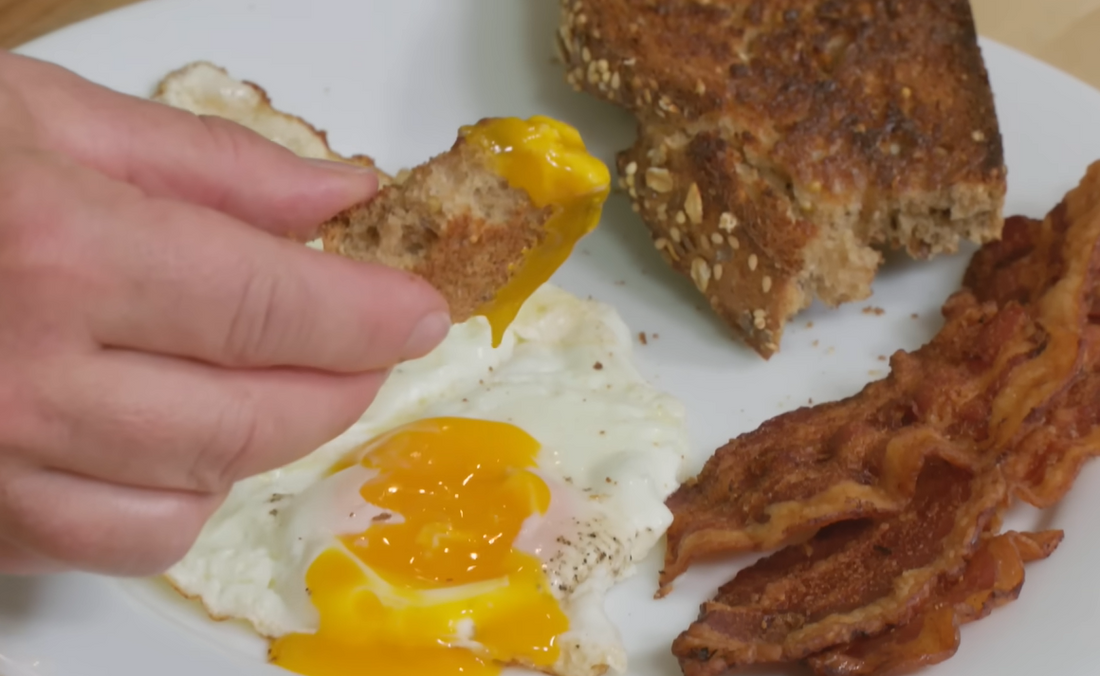
Can you cook a fried egg in the microwave? Explained
Can you cook a fried egg in the microwave? Yes, you can cook a fried egg in the microwave, but it’s important to note that the results might not be exactly the same as when cooked on a stovetop. While you won’t get the same crispy edges or the visual sizzle, you can achieve a cooked egg with a firm white and a runny yolk (if desired) using the microwave. However, the key is to follow specific techniques to prevent overcooking or undercooking, and to ensure the egg is cooked safely.

Microwave Egg Cooker | Non-Stick Egg Fryer & Poacher | Make Egg McMuffin, Eggwich, Breakfast Sandwiches & Hamburger Patties
Is It Safe to Fry Eggs in the Microwave?
Yes, it's generally safe to cook a fried egg in the microwave as long as you follow some basic safety precautions. Microwaving eggs can be quick and convenient, but because microwaves heat unevenly, there are a few things to keep in mind to avoid accidents or an unpleasant cooking experience.
Safety Tips When Microwaving a Fried Egg
Always use a microwave plate or bowl. Avoid using metal containers, as they can cause sparks and even start a fire. Opt for ceramic or glass dishes that are labeled safe for microwave use.
Place a microwave food cover, such as a microwave-safe lid or a paper towel, over the egg to prevent splattering. This will help retain heat and keep the egg from making a mess inside the microwave.
It’s crucial to pierce the yolk with a fork or toothpick before microwaving. If you don’t, the yolk can build up pressure and burst, potentially creating a mess or causing a minor safety hazard in your microwave.
Microwaves heat food unevenly, so it’s best to cook your egg in short intervals (about 20-30 seconds) and check the progress. This helps prevent overcooking and ensures that the egg cooks evenly.
Microwaves can cook eggs quickly, and overcooking can result in a tough, rubbery texture. Keep an eye on the egg, especially if you like the yolk runny. If the white isn’t fully set, you can always microwave it for a few more seconds.
How to Cook a Fried Egg in the Microwave?
Cooking a fried egg in the microwave is quick, easy, and a great alternative when you’re short on time or don’t want to deal with the hassle of using a stove. While the texture won’t be identical to traditional frying (no crispy edges here), you can still achieve a perfectly cooked egg with a runny yolk and firm whites if done right. Here’s a detailed, step-by-step guide to microwaving a fried egg:
Gather Your Ingredients and Equipment
- 1 egg
- A microwave-safe dish (dedicated egg cooker works best)
- A microwave-safe cover (lid or paper towel)
- Fork or toothpick (for piercing the yolk)
- Butter or oil (optional, for flavor)
- Salt and pepper (optional, for seasoning)
Prepare Your Microwave-Safe Dish: Choose a dish that is large enough to allow the egg to spread out a bit. A small, flat plate works best for mimicking the classic fried egg shape. If you want a slightly crispy texture or to avoid sticking, you can lightly grease the plate with a bit of butter or oil. Use just enough to coat the surface, but don’t drown the egg in fat.
Crack the Egg into the Dish: Gently crack the egg into the center of your dish. Be careful not to break the yolk unless you prefer a scrambled egg. For a fried egg with a runny yolk, do not pierce the yolk yet, but for safety reasons, it’s always a good idea to pierce the yolk before microwaving. This prevents the yolk from building up pressure and bursting during cooking.
Pierce the Yolk: Using a fork or toothpick, gently pierce the yolk. This is an essential step to avoid the yolk exploding in the microwave. The hole should be small, just enough to let steam escape during cooking. Be careful not to pierce the egg white unless you’re looking to make scrambled eggs.
Cover the Egg: Cover the dish with a microwave-safe lid or a paper towel. This prevents the egg from splattering all over the microwave and helps retain moisture, giving you a softer texture. Ensure the cover isn’t tightly sealed. leave a small gap will allow steam to escape.
Microwave the Egg: Place the dish in the microwave and cook the egg on high for 30 seconds. After the first 30 seconds, check the egg to see how it's cooking. If the white is still runny, continue microwaving in 10-15 second intervals, checking each time, until the white is fully set but the yolk is still intact.
For a runny yolk, the total cook time should generally range from 45 seconds to 1 minute, depending on the microwave’s wattage. For a fully cooked yolk, microwave for 1 minute to 1 minute 15 seconds. If you want the yolk firm, increase the time in 10-second intervals.
Check the Egg’s Doneness: After microwaving, check if the white is completely set and opaque. The yolk should remain intact, soft, and runny unless you’ve cooked it longer for a fully set yolk. If you find that the egg is undercooked, simply microwave it for an additional 5-10 seconds at a time until it reaches your desired doneness.
Remove the Egg and Let It Rest: Carefully remove the dish from the microwave. Be cautious, as it may be hot. Let the egg sit for about 30 seconds to allow any residual heat to finish cooking the egg. This ensures the yolk won’t be too runny or too firm.
Season and Serve: Add your favorite seasonings, such as salt and pepper, or any other toppings (cheese, hot sauce, herbs). The beauty of microwaving eggs is that you can experiment with minimal effort! Serve immediately on toast, as part of a sandwich, or alongside other breakfast favorites.
Benefits of Microwaving Fried Eggs
Microwaving fried eggs offers several advantages over traditional stovetop cooking. If you’re looking for a faster, more convenient way to enjoy a delicious egg, the microwave is a game-changer. Here’s a breakdown of the key benefits:
Speed and Efficiency
One of the most significant advantages of microwaving a fried egg is how quickly you can cook it. Traditional frying takes a few minutes on the stovetop, but when you microwave an egg, it usually takes less than a minute to cook, depending on the desired doneness. This makes it ideal for busy mornings when you need a quick breakfast or even a last-minute snack.
Microwave Time: A fried egg can be ready in as little as 45 seconds to 1 minute, compared to 4–5 minutes on the stovetop.
No Preheating Required: Unlike a pan, the microwave doesn't need to be preheated, saving you additional time.
Convenience
Microwaving eggs is incredibly convenient, especially for those who don’t have the time or patience for traditional cooking methods. No need to deal with multiple pans, cooking oils, or adjusting the heat.
No Mess: Unlike frying on the stovetop, which can lead to greasy splatters and messy cleanup, microwaving an egg is a clean and tidy process. You can easily wipe down the dish afterward.
No Special Skills Required: You don’t need to be an expert cook to microwave a fried egg. The process is simple, and anyone can do it in just a few steps.
Minimal Clean-Up
One of the most appealing aspects of microwaving a fried egg is the minimal clean-up involved. Traditional frying can leave you with a pan to wash and possibly splattered surfaces to clean up. With the microwave, you’re typically left with just a plate or bowl.
Fewer Dishes: You only need one microwave-safe plate or bowl. You don’t need multiple pans or utensils, making cleanup much faster and easier.
Less Grease: Because you don’t need to use as much butter or oil, there’s less grease to clean up, which means less scrubbing and wiping.
What is the Healthiest Way to Fry Eggs?
Fried eggs can be part of a healthy diet, but the method you use to cook them can have a significant impact on their nutritional profile. When it comes to frying eggs, the key is minimizing added fats and choosing healthy cooking methods to retain the egg's natural nutrients without increasing unhealthy fats or calories.
Use a Healthier Fat for Frying
Traditional frying often involves using butter or oil, which can add a lot of unhealthy saturated fats and extra calories. To make your fried eggs healthier, opt for heart-healthy oils like:
- Olive oil: Rich in monounsaturated fats, it’s a great choice for frying eggs. You can use a small amount to cook the eggs without compromising on flavor.
- Avocado oil: High in monounsaturated fats and has a high smoke point, making it ideal for frying at higher temperatures.
- Coconut oil (in moderation): While it contains saturated fats, coconut oil is a good option for a subtle flavor and is stable at high temperatures.
Use Minimal Oil
Instead of drowning the egg in oil, use just enough to lightly coat the pan. You can also use a non-stick pan to reduce the amount of fat needed, or use a spray oil to control the amount more precisely. Using too much oil adds extra calories and fat, so stick to a small drizzle or use a brush to spread it evenly.
Cook on Medium to Low Heat
Frying eggs at high heat can result in the oils breaking down, creating potentially harmful compounds. Cooking on medium or low heat ensures that your eggs cook evenly while preserving the quality of the oil. It also prevents the eggs from becoming overly crispy or burned, which can affect both flavor and nutritional quality.
Consider Poaching or Scrambling as Alternatives
While pan-frying is delicious, poaching eggs is a healthier alternative because it requires no added fat. Simply cook the eggs in water, and they will retain their nutrients without additional calories from oil or butter. Scrambled eggs can also be made healthier by using minimal fat and adding vegetables for extra fiber and nutrients.
Add Vegetables or Lean Proteins
Make your fried egg meal more nutrient-dense by incorporating vegetables like spinach, mushrooms, or tomatoes into the dish. You can also add lean proteins like turkey bacon or grilled chicken for a balanced, healthy meal.
Conclusion
Microwaving eggs is quick, safe, and convenient with proper techniques. From safety tips like piercing the yolk to detailed cooking steps, it’s easy to enjoy perfectly cooked eggs while avoiding common mistakes. Embrace the health benefits, experiment with recipes, and even reheat eggs effectively for a nutritious, hassle-free experience.
Add a Microwave Egg Cooker to Your Microwave Cookware Collection
A microwave egg cooker is a must-have addition to your microwave cookware, offering a fast, easy, and mess-free way to cook eggs. Whether you're scrambling, boiling, or poaching, it ensures consistent results every time. Simplify your cooking routine and enjoy perfectly cooked eggs with this essential kitchen tool!








